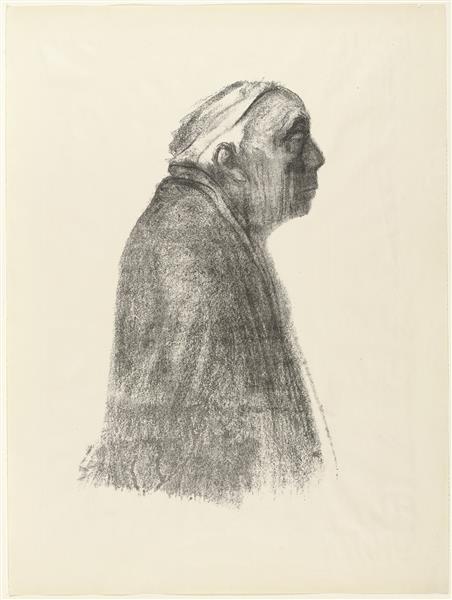Description
The work "Profile self -portrait to the right" of 1938, created by the outstanding German artist Käthe Kollwitz, is a powerful testimony of the individual who faces the adversities of the world. This self -portrait, which encapsulates both the fragility and the strength of the human being, is an intimate expression that resonates deeply with the historical reality of its time. Kollwitz, often recognized for his humanistic approach in art and his commitment to the representation of suffering and social struggle, uses this self -portrait to offer a window to his own psyche and his understanding of the world.
The composition of the work is remarkable in its simplicity and depth. The use of the profile, an choice that reminds of the portrait techniques of past times, transmits a sense of introspection. The figure of the artist is presented in a clearly delineated profile, which allows the spectator to concentrate on the subtleties of his expression and the face of the face. The color palette is moderate and terrous, dominated by dark and shaded tones, which add an atmosphere of introspection and melancholy. The lack of vibrant colors reinforces the seriousness of the self -portrait, while echoing the experiences lived by Kollwitz in a Europe whipped by wars and crisis.
The treatment of light and shadow in the work is particularly significant. Kollwitz uses these techniques to emphasize the factions of his face, creating a contrast that illuminates his forehead and accentuates the shadow of his jaw and neck. This manipulation of the clear-dark not only gives volume to his figure, but also suggests an emotional tension, as if Kollwitz herself were dealing with the loads that weigh on her shoulders. This tension is emblematic of his style, in which the personal and the political often converge.
The absence of secondary characters in this work further highlights the individuality of the artist. Kollwitz introduces herself as the only subject, suggesting that the role of the artist is ultimately one of loneliness and reflection. Through her introspective gaze, she invites the viewer to consider not only her own suffering and the human condition, but also the individual's relationship with society. This connection can be seen in other works by Kollwitz, where the characters usually embody the struggle of the masses, but here, attention focuses on the individual being and their experiences.
The work "Profile self -portrait to the right" is in a broader context of expressionism and symbolism, styles that greatly influenced Kollwitz's work. His approach to human pain and injustice is a constant in his career and is reflected in other pieces such as "the mother" or "the peasants", where the human figure, whether in a group or individual, is always the center of his artistic speech. The self -portrait, although more introspective, is not isolated in this regard; It is a continuation of its aesthetic and social concerns, an echo of its search for empathy and connection.
In conclusion, "self -portrait to the right" is much more than a simple representation of the artist; It is a deep exploration of the identity, vulnerability and commitment of the human being with his environment and time. Käthe Kollwitz uses this self -portrait to tell us not only of itself, but also of a multitude of voices that have been silenced throughout history. Through his art, Kollwitz invites us to confront our own struggles and experiences, reminding us that, ultimately, we are all connected in our humanity.
KUADROS ©, a famous paint on your wall.
Hand-made oil painting reproductions, with the quality of professional artists and the distinctive seal of KUADROS ©.
Art reproduction service with satisfaction guarantee. If you are not completely satisfied with the replica of your painting, we refund your money 100%.

